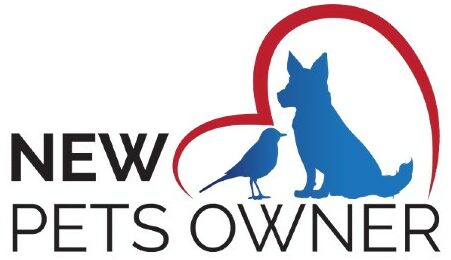The merle corgi appearance is hard to miss. It looks unlike any other, catching the eye of many dog enthusiasts. The mottled corgi coat pattern is not often found in this breed, making it a real beauty when seen. This look comes from special genetics, giving the Corgi distinctive colors. These colors mix in patches and swirls, making each Corgi with this look stand out.
The merle color style is not accepted in Pembroke Welsh Corgis by who decide these things. They prefer solid colors usually. However, the merle pattern comes when corgis get genes from dogs that are already merle. This creates a really unique coat that many people love. Even without formal recognition, people value merle corgis for their smartness, loyalty, and friendly nature.
If you’re thinking of getting a corgi, knowing about the merle gene is important. This gene can cause health problems related to vision and hearing. It’s key for breeders to be careful and for buyers to be informed. Still, the merle corgi wins over hearts with its special looks.
Understanding the Corgi Breed
The Corgi breed is a proud symbol of Wales, well-known for its history and unique looks. When we look closer, we find two main types: the Pembroke Welsh Corgi and the Cardigan Welsh Corgi. They both come from Wales but have different stories.
The History of Pembroke and Cardigan Welsh Corgis
The story of the Corgi breed is quite interesting. The Pembroke and Cardigan Corgis come from Wales and were used for herding. This work showed their cleverness and ability to do various tasks.
The Pembroke Corgi is especially linked to Queen Elizabeth II, who has owned them since 1944. On the other hand, the Cardigan Corgi has a different history, working more closely with shepherds to handle cattle.
A big difference in their stories is their ancestry that split over a thousand years ago. The Cardigans have roots with Nordic settlers while the Pembrokes’ past connects to Flemish people.
Distinct Physical Characteristics of Corgis
Pembrokes and Cardigans look different, and this often draws people to them. Pembrokes are short with docked tails and a face like a fox. Cardigans, however, are bigger, with long tails and rounder ears. These features are what make Corgis so easy to spot.
For a quick look at how Pembroke and Cardigan Corgis differ, check the table below:
| Trait | Pembroke Welsh Corgi | Cardigan Welsh Corgi |
|---|---|---|
| Tail | Docked/Short | Long |
| Ears | Pointed | Rounded |
| Size | Smaller and Lighter | Larger and Heavier |
Knowing the differences and histories of Pembroke and Cardigan Welsh Corgis helps us value these amazing breeds more. It also guides responsible care and breeding.
The Science Behind the Merle Coat Pattern
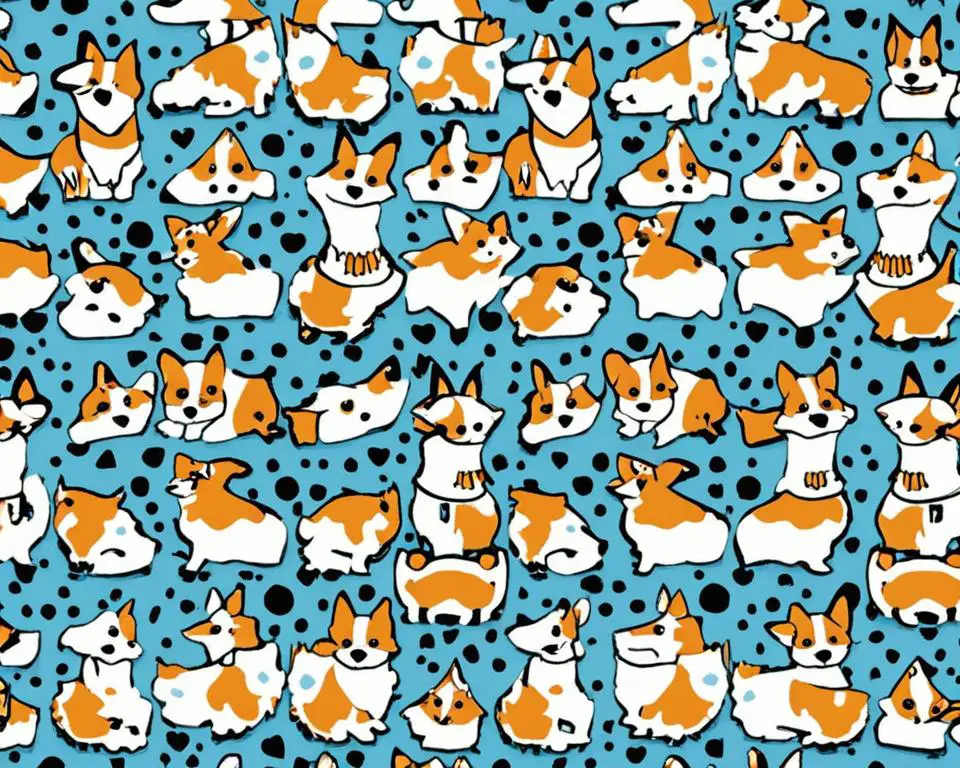
An exploration into the merle gene in dogs unveils how genetic elements mix. This mix creates unique dog coat color patterns. The gene that controls coat color and patterns plays a key role. This gene makes the merle pattern, which is known for its light patches on a dark background.
Genetics of Merle Coloring in Dogs
The merle gene in dogs is a dominant one. This means only one copy is needed for the merle pattern to show. But, the colors and patterns can look very different from dog to dog. This is because the merle gene can influence the coat’s colors randomly. It makes those marbled or mottled looks we see in merle dogs.
Types of Merle Patterns and Their Impact on Appearance
Merle patterns come in many varieties. They can be large patches of color or tiny speckles. How these patterns look affects the dog’s beauty and maybe its health. Breeders should know about these patterns deeply. It helps them avoid genetic mixes that can cause ear or eye problems.
Understanding coat color genetics and the merle gene is crucial for breed lovers and breeders. This understanding helps in caring for dogs. It ensures their coats are not only stunning but also healthy for generations to come.
Exploring the Rarity of Merle Corgis
The allure of rare merle Corgis grabs the attention of dog lovers globally. Yet, the reason behind the rarity of the merle pattern is closely tied to genetics and strict breed standards. Unique Corgi coats, such as the merle, show a special and eye-catching look but are hard to find due to genetic factors.
Merle Corgi characteristics are very uncommon. This is because the merle gene isn’t found naturally in Pembroke Welsh Corgis. What this means is any Pembroke with a merle pattern might not be purebred and could come from mixing breeds. In comparison, Cardigan Welsh Corgis can have the merle look naturally. This is and meets standards set by breed organizations.
| Breed | Merle Pattern Acceptance | Considerations |
|---|---|---|
| Pembroke Welsh Corgi | Not Naturally Occurring | Potentially Crossbred |
| Cardigan Welsh Corgi | Naturally Occurring | Accepted within Breed Standards |
When thinking about getting a rare merle Corgi, being informed is crucial. The breed presents unique interests but also complex biological matters. It’s important to support ethical breeding to safeguard the breed’s health and purity. People interested in unique Corgi coats should also be aware of possible health issues related to the merle gene. This highlights the need for responsible pet care.
Recognized Colors and Breed Standards for Corgis
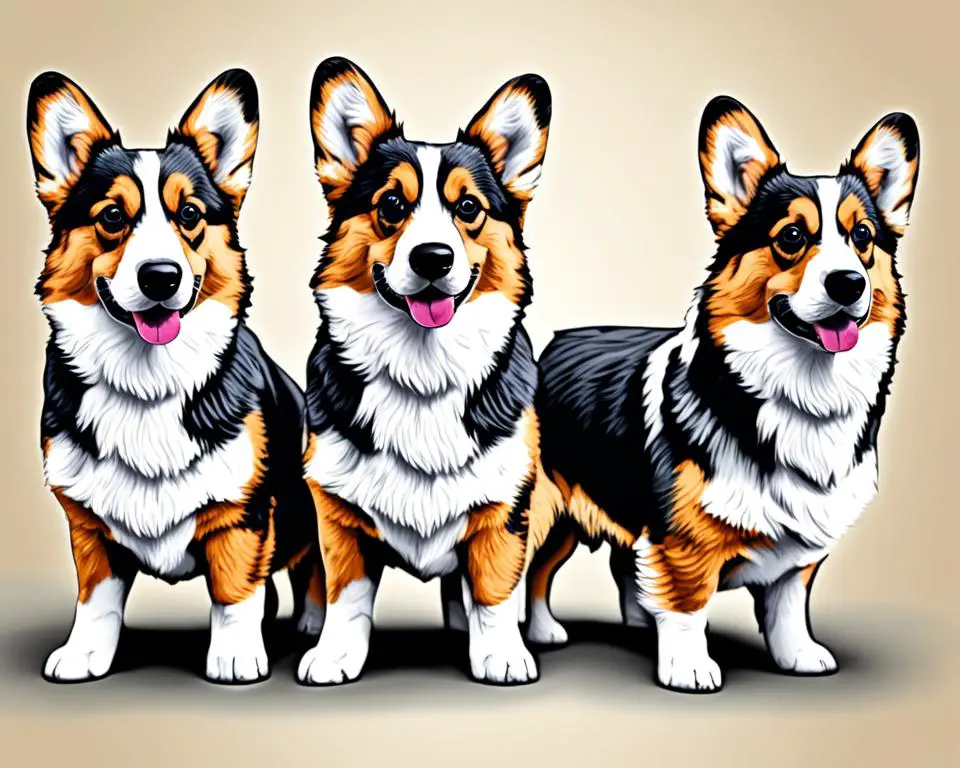
Corgis come in many colors, according to the AKC. Both Pembroke and Cardigan Welsh Corgis have various colors. Each adheres to unique standards, keeping their identities special.
American Kennel Club Guidelines for Corgi Coat Colors
Seeing the AKC’s stance on AKC Corgi coat colors is key for fans and breeders. These rules safeguard the breed’s purity and heritage. They also foster better breeding for stronger, healthier Corgis.
Comparing Pembroke and Cardigan Corgi Standards
Pembrokes and Cardigans differ in colors and patterns. The AKC highlights certain Pembroke Corgi colors and Cardigan Corgi variations. This preserves each breed’s special traits.
| Feature | Pembroke Welsh Corgi | Cardigan Welsh Corgi |
|---|---|---|
| Colors Recognized by AKC | Red, Sable, Fawn, Black and Tan | Red, Brindle, Blue Merle (unique to Cardigan), Black and Tan |
| White Markings | Usually minimal | More prominent; can include neck, chest, legs, muzzle, underparts |
| Unique Color Feature | No merle patterns allowed | Blue Merle, exclusive to the breed |
| Key Breed Standard Notes | Overall balance, correct size, and good disposition | Strongly boned, robust, and well-balanced |
Grasping Corgi breed standards helps lovers and breeders. It lets them celebrate the heritage and health of Pembroke and Cardigan Corgis. Every Blue Merle Cardigan and Red Pembroke upholds the breed’s history.
Ethical Breeding and Health Implications of Merle Corgis
The unique coat of a Merle Corgi captures our eyes, but it also brings big health considerations and ethical breeding duties. Putting the dog’s health first is key in responsible dog breeding practices. It means breeders and owners are aware of the challenges, like the merle gene health risks.
Potential Health Concerns Linked to the Merle Gene
Merle gene-related dangers focus on sensory issues. Mainly, puppies with two merle copies often have deep sight and hearing problems. Knowing this is vital for ethical Corgi breeding. It helps control health problems, such as not breeding two merle Corgis together.
For deep insights into Merle Corgis, check out merle gene health risks. It includes detailed guidelines and what breeders should do.
Responsibilities of Breeders in Preserving Corgi Health
Faithfulness to AKC standards, health screenings, and genetic checks are crucial. These checks are not just steps to follow. They are vital for breeders to decide well, putting puppies’ and breed’s health first.
| Feature | Description |
|---|---|
| Average Lifespan | 12 to 15 years |
| Height Range | 10.5 to 12.5 inches |
| Weight Range | 25 to 38 pounds |
| Energy Level | Moderate, requires regular exercise |
| Personality Traits | Loyal, affectionate, and alert |
Dedication to ethical Corgi breeding means caring for looks and health alike. By sticking to responsible dog breeding practices, breeders help Merle Corgis enjoy long, healthy lives, away from genetic issues.
Merle Corgi: The Misconceptions and Realities
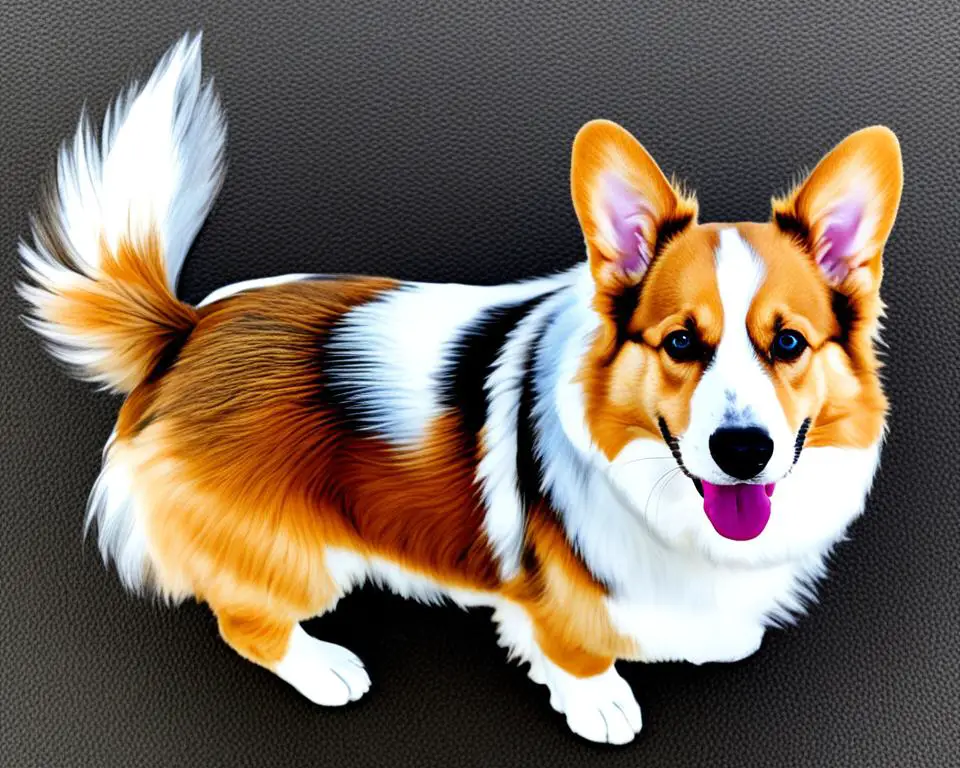
Merle Corgis hold a special place in the dog world, drawing many to their beauty. However, they are often shrouded in merle Corgi myths and misunderstandings. Understanding the science of merle coloration and its history helps us see through these myths. It also lets us appreciate the Corgi breeding misconceptions in a new light.
A big myth is that seeing merle color means a Corgi is purebred. But the truth is, this color mostly shows there’s been mixed breeding. Learning about merle coloring and Corgi genetics is key to noticing these myths.”
| Fact | Myth |
|---|---|
| Merle coloration in Corgis is the result of mixed breeding. | Merle Corgis are purebred. |
| Merle pattern has been officially recorded in some breeds since the 1800s. | Merle is a modern, artificially created color pattern. |
| Health issues related to merle gene are due to specific genetic combinations, not merle itself. | Merle coloration directly causes health problems. |
The merle gene first showed its color change power over a hundred years ago. It appeared in the Border Collie and Australian Shepherd, not in Corgis at first. This shows us just how complicated dog genes and breeding can be. This complexity makes breeding for health very important.
There are times when merle coloring pops up in breeds it didn’t use to be in. This can happen through hidden mixing of breeds. But this mixing can damage breed health. We need strict breed tests to stop this, but these tests can’t always show the breed’s true lineage past a few generations.
Understanding these truths changes how we talk about merle Corgis. We move towards a more informed and ethical way of breeding and owning them. It’s key for both future owners and breeders to use reliable information and genetic tests. This ensures the breed’s health and purity. By dispelling common myths and explaining the complex genetics of merle, we aim for ethical and sustainable breeding practices with Corgis and other breeds.
The Role of Genetic Testing in Corgi Breeding
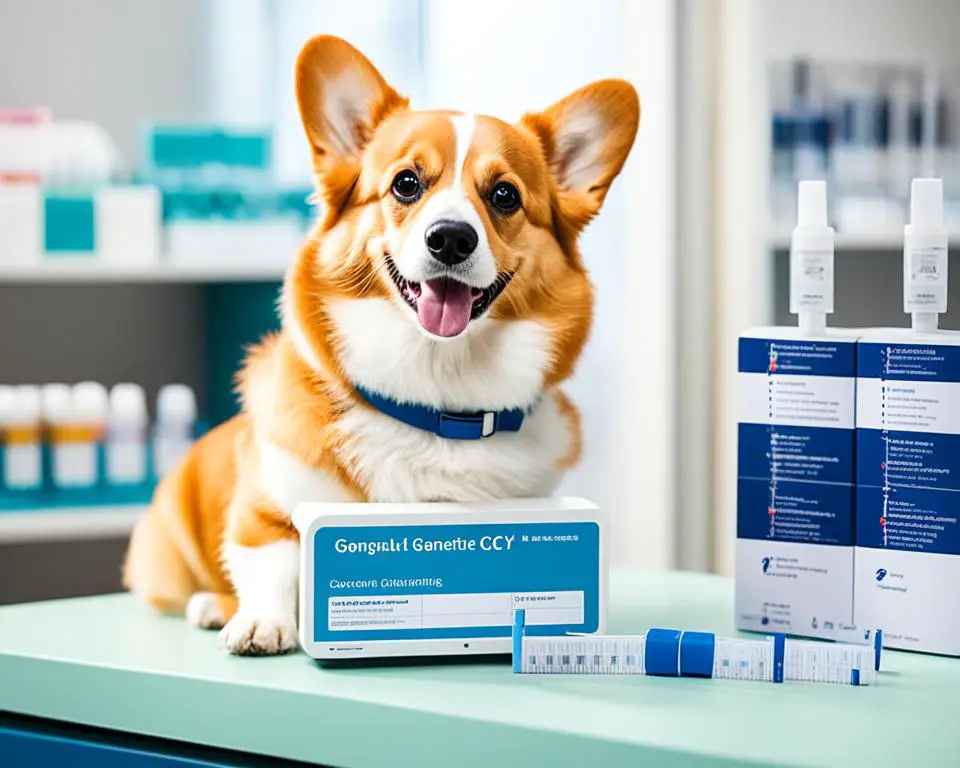
The way breeders manage responsible Corgi breeding has transformed with genetic testing for Corgis. They can use tests to look out for diseases, keeping the breed healthy. This method also makes sure there’s enough genetic diversity in Corgis.
Identifying Responsible Breeding Practices
Using genetic testing is key to responsible breeding. It spots diseases that Corgis might pass to their pups. Breeding for genetic diversity helps steer clear of health and behavior problems linked to inbreeding.
The Importance of Genetic Diversity in Corgis
For any breed to stay strong, maintaining a wide range of genetics is vital. Breeders need to know the genetic backgrounds of their Corgis well. This stops the genetic pool from getting too small, especially in smaller breeds.
The more genetic variety in a breed, the stronger and healthier they will be.
| Aspect | Without Genetic Testing | With Genetic Testing |
|---|---|---|
| Incidence of Hereditary Diseases | Higher likelihood | Significantly reduced |
| Breeding Pair Compatibility | Unknown genetic match | Optimized for genetic diversity |
| Longevity of Species | Potentially compromised | Enhanced overall health and lifespan |
Genetic testing lets breeders make better, ethical choices. They help not just one dog but the whole Corgi line.
Cardigan Welsh Corgis and the Blue Merle Variant

Blue merle Cardigan Corgis are known for their striking looks and unique coat colors. They have a mix of blue, gray, and black colors. This mix shows their special genetic makeup. They’re loved not just for their looks, but also for their loving nature and strong build.
Distinguishing Features of Blue Merle Cardigan Corgis
These Corgis stand out because of their beautiful and unusual coats. Their fur is a mix of blue, black, and gray. Some have bright blue or different colored eyes. This is all because of their special genes, which makes them eye-catching.
Blue Merle: A Recognized and Celebrated Coat
The Cardigan Corgi’s blue merle coat is a special trait not found in Pembrokes. This coat is celebrated and highlighted in breed standards. It makes them stand out and be sought after for both shows and as pets.
| Feature | Description | Genetic Influence |
|---|---|---|
| Coat Color | Blue, gray, and black patches | Merle gene complexity |
| Eye Color | Blue or heterochromatic | Direct linkage to merle genetics |
| Recognition | Standard in breed guides | Emphasis on unique Cardigan coat patterns |
Uncovering the Appeal of Merle Corgi Puppies
The allure of the merle Corgi puppy appeal is undeniable. These dogs have unique patterns and colors. They often become the center of attention. This sparks interest in many who dream of owning a Corgi. But, deciding to bring one of these charming Corgi types into your home is serious. It’s important to know that the merle pattern is mostly seen in the Cardigan Welsh Corgi. Ethical breeding practices are key for the breed’s health and energy.
What Prospective Owners Should Know
Before being enchanted by a merle Corgi puppy, it’s wise to do your homework. Researching the breed and the merle color is crucial. You need to know the responsibilities of owning such a unique dog. This includes keeping them healthy and understanding the merle gene’s effects. Knowing how the merle pattern is passed down and potential health issues is important. It helps you make a wise choice. Also, selecting breeders who do genetic testing and follow the American Kennel Club’s guidelines is vital.
The Fascination with Unique Corgi Coat Patterns
The merle Corgi’s coat, especially the merle pattern, is loved by many. Their unique looks have won over dog lovers. However, the merle Corgi’s popularity should not overshadow the need for the breed’s overall health. Prospective owners should know a lot about the breed. This includes its history, looks, and health issues. Being well-informed and passionate is the best way to care for these special pets. Making smart and caring choices ensures a good life for the merle Corgi.
Source Links
- https://blog.tryfi.com/merle-coat-pembroke-welsh-corgis-guide/
- https://www.dogster.com/lifestyle/corgi-colors-and-patterns
- https://iheartdogs.com/corgi-colors-stunning-variations-with-pictures/
